Care and Maintenance of a Trumpet
Weekly care and maintenance
Cleaning the slides
Carefully remove the slides and wrap a polishing gauze around a cleaning rod so that the metallic part of the cleaning rod's tip is not exposed. Now proceed as follows:
- Remove the dirt from inside the middle and outer slides.
- Lubricate the slides that have triggers attached to them (the first and third slides) using tuning slide oil. Work each slide back and forth two or three times to work in the oil.
- Apply a small amount of slide grease to the slides that do not have triggers attached to them (the main slide and the second slide). Work each slide back and forth two or three times to work in the grease.
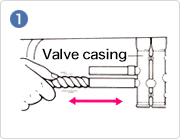
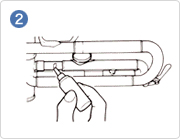
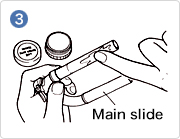
Proper use of grease and oil
Apply slide grease to the main tuning slide and the second valve slide, and tuning slide oil to the first and third valve slide.
Oil is applied to allow smooth movement while playing, so that the first and third valve slides can be used to control pitch. If grease, such as that used on the main tuning slide and second valve slide, is applied to these components, it will be more difficult to achieve a smooth movement. On the other hand, because movement of the main tuning slide and second valve slide during play is undesirable, tuning slide oil is not used on these parts.
This is the reason grease and oil are used differently.
Washing the mouthpiece
Make up a solution of brass soap, consisting of 10-15 parts warm water (30°C-40°C) to one part brass soap. Soak a mouthpiece brush in the brass soap solution and clean the mouthpiece by pushing the brush through the throat. Now use clean water to wash off the mouthpiece.
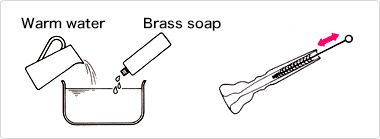
Clean the intricate parts too
Twist a polishing gauze into a thin strand and use it to carefully clean the intricate parts of the instrument.
Cleaning the water key hole
Use a tone-hole cleaner to remove dirt from the water-key hole.
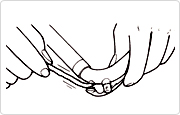
Musical Instrument Guide:Trumpet Contents
Structure
How the Instrument is Made
Choosing an Instrument
Care and Maintenance
Trivia
- Trumpeters in Bach's time alternated between instruments with a variety of ranges when performing
- The keyed trumpet-the fruit of the evolutionary process
- Famous trumpet works - Concertos, part 1
- Famous trumpet works - Concertos, part 2
- Famous trumpet works - Solos
- Is a Flugelhorn a horn? Or a trumpet?
- The highest note a trumpet can produce
- Aida trumpets for the "Grand March"
- The secret of the trumpet's traditional tone: small impurities!?
